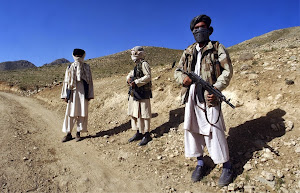Will the U.S. still be meddling in Afghanistan 30 years from now? If history is any guide, the answer is yes. And if history is any guide, three decades from now most Americans will have only the haziest idea why.
Since the 1950s, the U.S. has been trying to mold that remote land to its own desires, first through an aid “war” in the midst of the Cold War with the Soviet Union; then, starting as the 1970s ended, an increasingly bitter and brutally hot proxy war with the Soviets meant to pay them back for supporting America’s enemies during the war in Vietnam. One bad war leads to another.
From then until the early 1990s, Washington put weapons in the hands of Islamic fundamentalist extremists of all sorts -- thought to be natural, devoutly religious allies in the war against “godless communism” -- gloated over the Red Army’s defeat and the surprising implosion of the Soviet empire, and then experienced its own catastrophic blowback from Afghanistan on September 11, 2001. After 50 years of scheming behind the scenes, the U.S. put boots on the ground in 2001 and now, 12 years later, is still fighting there -- against some Afghans on behalf of other Afghans while training Afghan troops to take over and fight their countrymen, and others, on their own.
Through it all, the U.S. has always claimed to have the best interests of Afghans at heart -- waving at various opportune moments the bright flags of modernization, democracy, education, or the rights of women. Yet today, how many Afghans would choose to roll back the clock to 1950, before the Americans ever dropped in? After 12 years of direct combat, after 35 years of arming and funding one faction or another, after 60 years of trying to remake Afghanistan to serve American aims, what has it all meant? If we ever knew, we’ve forgotten. Weary of official reports of progress, Americans tuned out long ago.
Back in 1991, as Steve Coll reports in Ghost Wars, an unnamed CIA agent mentioned the war in Afghanistan to President George H.W. Bush. Not long before, he had okayed the shipment of Iraqi weaponry captured in the first Gulf War -- worth $30 million -- to multiple factions of Islamist extremists then battling each other and probably using those secondhand Iraqi arms to destroy Afghanistan’s capital, Kabul. Still, Bush seemed puzzled by the CIA man’s question about the war. He reportedly asked, “Is that thing still going on?”
Such forgetfulness about wars has, it seems, become an all-American skill. Certainly, the country has had little trouble forgetting the war in Iraq, and why should Afghanistan be any different? Sure, the exit from that country is going to take more time and effort. No seacoast, no ships, bad roads, high tolls, IEDs. Trucking stuff out is problematic; flying it out, wildly expensive, especially since a lot of the things are really, really big. Take MRAPs, for example -- that’s Mine-Resistant Ambush-Protected vehicles -- 11,000 of them, weighing 14 tons or more apiece. For that workhorse transport plane, the C-17, a full load of MRAPs numbers only four.
The equipment inventory keeps changing, but estimates run to 100,000 shipping containers and about 50,000 vehicles to be removed by the end of 2014, adding up to more than $36 billion worth of equipment now classified as “retrograde.” The estimated shipping bill has quickly risen to $6 billion, and like the overall cost of the war, it is sure to keep rising.
Seven billion dollars worth of equipment -- about 20% of what the U.S. sent in to that distant land -- is simply being torn up, chopped down, split, shredded, stomped, and, when possible, sold off for scrap at pennies a pound. Toughest to break up are the weighty MRAPs. Introduced in 2007 at a cost of $1 million apiece to counteract deadly roadside bombs, they were later discovered to be no better at protecting American soldiers than the cheaper vehicles they replaced. Of the 11,000 shipped to Afghanistan, 2,000 are on the chopping block, leaving a mere 9,000 to be flown to Kuwait, four at a time, and shipped home or “repositioned” elsewhere to await some future enemy.
The military is not exaggerating when it calls this colossal destruction of surplus equipment historic. A disposal effort on this scale is unprecedented in the annals of the Pentagon. The centerpiece of this demolition derby may be the brand-new, 64,000-square-foot, $34-million, state-of-the art command center completed in Helmand Province just as most U.S. troops left, and now likely to be demolished. Or the new $45 million facility in Kandahar built as a repair center for armored vehicles, now used for their demolition, and probably destined to follow them. Taxpayers may one day want to ask some questions about such profligate and historic waste, but it’s sure to keep arms manufacturers happy, resupplying the military until we can get ourselves into another full-scale war.
So this exit is a really big job, and that’s without even mentioning the paperwork. All those exit plans, all the documents to be filed with the Afghan government for permission to export our own equipment, all the fines assessed for missing customs forms (already running to $70 million), all the export fees to be paid, and the bribes to be offered, and the protection money to be slipped to the Taliban so our enemies won’t shoot at the stuff being trucked out. All that takes time.
But when it comes right down to it, the United States has a surefire way of ending a war, no matter when it actually ends (or doesn’t). When we say it’s over, it’s over.
Enduring Operation Enduring Freedom
As it happens, things probably won’t be quite so decisively “over” for everybody. More
